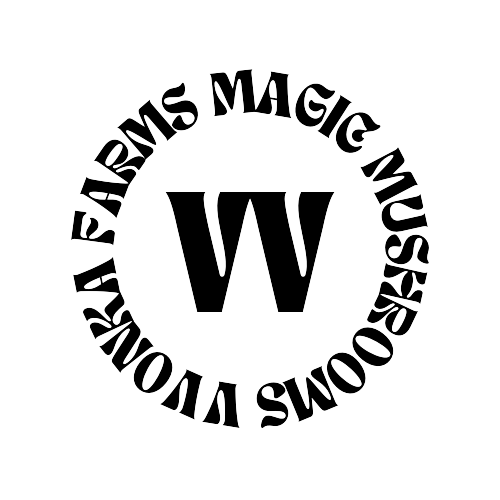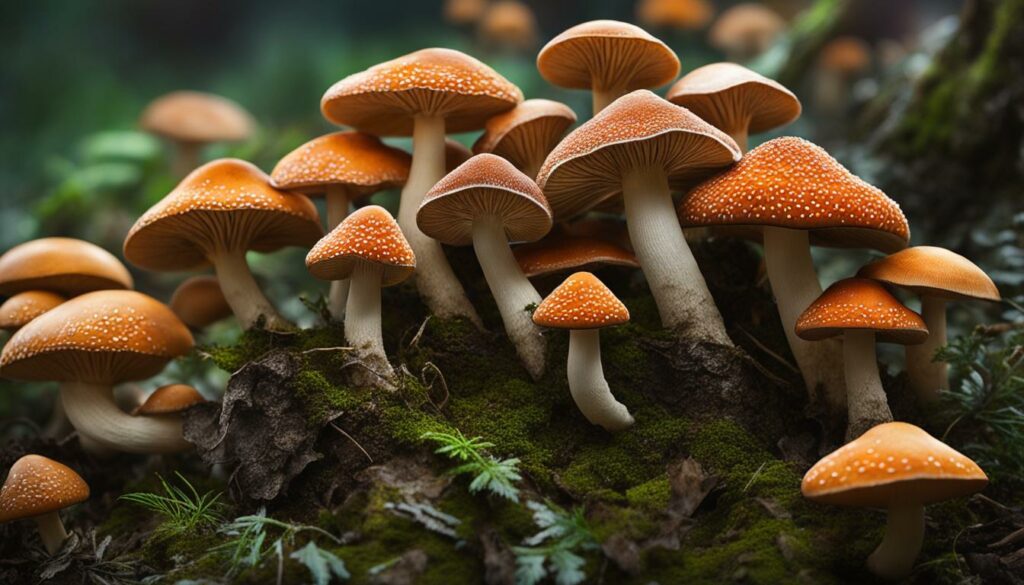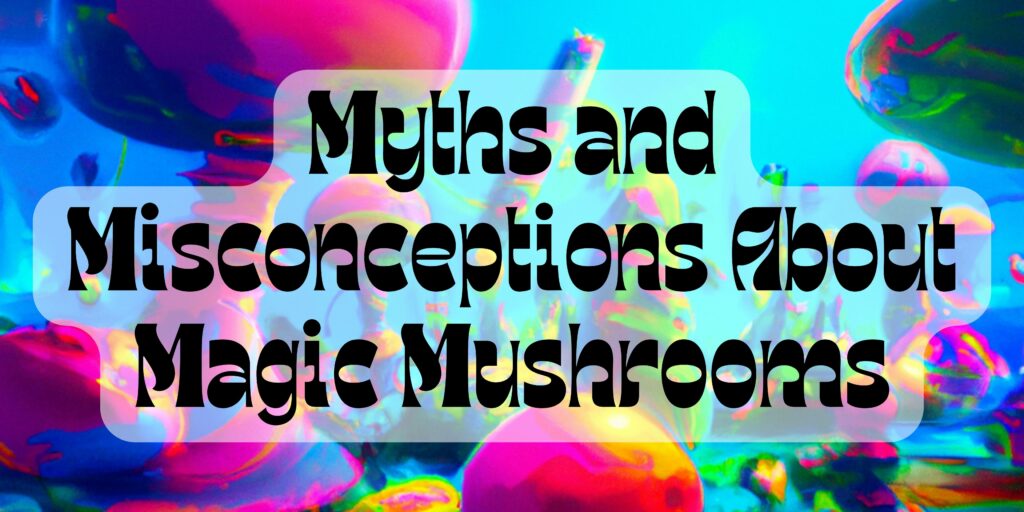Welcome to our visual guide on one of the most common questions about magic mushrooms: what does one gram of shrooms actually look like? In this article, we will explore the physical characteristics, size, and appearance of one gram of magic mushrooms to provide you with a clear visual representation.
Before we dive into the details, it’s important to note that the weight, size, and appearance of magic mushrooms can vary depending on the species and individual samples. However, we will focus on the general characteristics of one gram of shrooms to give you a better understanding.
Key Takeaways:
- One gram of shrooms typically consists of dried magic mushrooms.
- The weight, size, and appearance of magic mushrooms can vary between species and samples.
- Psilocybe cubensis is the most common species, with an average psilocybin content of around 0.7% by weight.
- The psilocybin content of one gram of dried Psilocybe cubensis mushrooms is approximately 10 milligrams.
- It is important to note that the psilocybin content can vary significantly between samples and species of magic mushrooms.
Understanding Psilocybin and Magic Mushrooms
Psilocybin is the compound found in magic mushrooms that is converted into psilocin in the body. Psilocin is the active compound responsible for the psychedelic effects of magic mushrooms. Psilocin interacts with serotonin receptors in the brain, leading to altered perception, mood changes, and hallucinations. This is why magic mushrooms are often used for their mind-altering properties.
Psilocybin and psilocin are both classified as tryptamines, a class of compounds that have similar effects on the brain. According to a study published in the Journal of Psychoactive Drugs, psilocybin and psilocin have a high affinity for serotonin receptors, particularly the 5-HT2A receptor. Activation of these receptors triggers a cascade of events in the brain, resulting in the characteristic psychedelic effects experienced with magic mushrooms.
One of the key neurotransmitters affected by psilocybin and psilocin is serotonin. Serotonin plays a crucial role in regulating mood, cognition, and perception. By binding to serotonin receptors, psilocin disrupts the normal functioning of serotonin in the brain, leading to profound changes in consciousness.
Psilocin is the active compound responsible for the psychedelic effects of magic mushrooms.
The Role of Serotonin
Serotonin is a neurotransmitter that is involved in various physiological and psychological processes in the body. It is commonly known as the “feel-good” neurotransmitter due to its role in regulating mood and feelings of well-being. Serotonin is also involved in regulating appetite, sleep, and sexual function.
When psilocin binds to serotonin receptors, it alters the normal communication between neurons, resulting in an increase in serotonin activity. This increase in serotonin activity is believed to be responsible for the profound alterations in perception, mood, and consciousness experienced during a magic mushroom trip.
Magic mushrooms have been used for centuries in various cultural and spiritual practices for their ability to induce altered states of consciousness. The understanding of psilocybin and its effects on the brain is still evolving, but research suggests that it holds promise for therapeutic applications, particularly in the treatment of mental health conditions such as depression and anxiety.
| Compound | Psilocybin | Psilocin |
|---|---|---|
| Chemical Structure | C11H17N2O4P | C12H16N2O |
| Origin | Found naturally in magic mushrooms | Metabolized from psilocybin in the body |
| Psychedelic Effects | Converts to psilocin and interacts with serotonin receptors in the brain | Binds to serotonin receptors, leading to altered perception and mood changes |
| Duration of Effects | Longer-lasting effects compared to psilocin | Shorter duration of effects compared to psilocybin |
Dosage and Psilocybin Content of Magic Mushrooms
When it comes to consuming magic mushrooms, understanding the dosage and psilocybin content is crucial to achieving the desired effects. Psilocybin content can vary significantly between samples and species, making it essential to have a general guideline to follow.
One of the most common species of magic mushrooms is Psilocybe cubensis, which typically contains around 0.7% psilocybin by weight. However, it’s important to note that this percentage can vary between samples and even different species of magic mushrooms. To determine the precise potency of a specific mushroom sample, lab testing is the only reliable method.
| Mushroom Species | Average Psilocybin Content |
|---|---|
| Psilocybe cubensis | 0.5-1.0% total psilocybin content |
| Other species (varies) | Unknown, requires lab testing for precise potency |
It’s important to note that the dosage of magic mushrooms is typically measured in grams of dried mushrooms. A common starting dose is between 1-2 grams, which can provide mild to moderate effects. However, the potency of mushrooms can vary, so it’s essential to start with a lower dose to gauge individual sensitivity.
Ultimately, understanding the dosage and psilocybin content of magic mushrooms is crucial for responsible and safe consumption. Always start with a low dose, be aware of individual sensitivities, and consider lab testing for precise potency if necessary.
Effects of Different Psilocybin Doses
Psilocybin, the active compound in magic mushrooms, produces a range of effects depending on the dosage consumed. Understanding the different dose levels can help individuals make informed decisions about their psychedelic experiences. Here, we explore the effects of low, medium, high, and ultra-high doses of psilocybin.
Low Dose (1 gram of dried mushrooms)
A low dose of 1 gram of dried magic mushrooms is often considered a threshold dose, meaning it produces subtle effects that can be felt but may not result in a full psychedelic experience. At this dose, individuals may experience enhanced senses, increased mood, and slight euphoria. The effects are typically mild and may be comparable to a microdose, where individuals seek the benefits of increased focus, creativity, and mindfulness.
Medium Dose (1.75 grams of dried mushrooms)
A medium dose of 1.75 grams of dried magic mushrooms is known to produce more pronounced effects. At this dose, individuals may experience open- and closed-eye visuals, deeper euphoria, and a heightened sense of connection to their surroundings. The psychedelic experience becomes more apparent, with a greater potential for introspection, creative thinking, and altered perception.
High Dose (3.5 grams of dried mushrooms)
A high dose of 3.5 grams of dried magic mushrooms can lead to a full-blown psychedelic experience. At this dose, individuals may experience intense visuals, profound shifts in consciousness, and a distortion of time and space. Cognitive and perceptual distortions are common, and emotional experiences can be deeply profound. This dosage is often sought after by those looking for transformative and therapeutic experiences.
Ultra-High Dose (5 grams of dried mushrooms)
An ultra-high dose of 5 grams of dried magic mushrooms is rarely consumed due to its overwhelming effects. At this dose, individuals may experience indescribable effects, including a complete dissolution of the ego and loss of normal perception of reality. It is important to note that an ultra-high dose should only be taken by experienced users in a safe and controlled environment.
It’s important to remember that individual experiences can vary, and the effects of psilocybin can be influenced by factors such as set (mindset), setting (environment), and personal tolerance. Always approach psychedelic substances with caution and respect, and consider consulting a healthcare professional before using them.
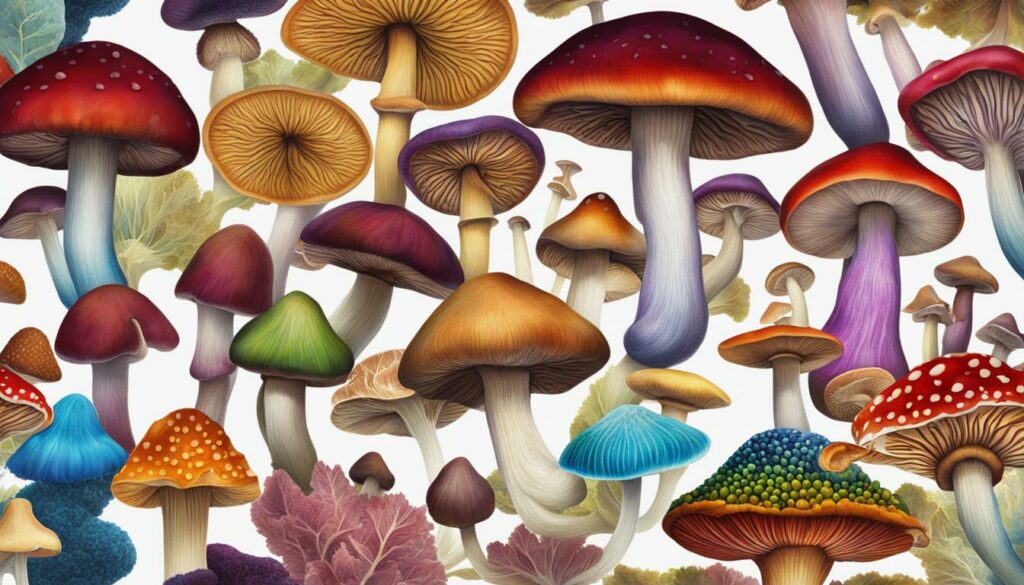
| Dose | Effects |
|---|---|
| Low (1 gram) | Enhanced senses, mood elevation, mild euphoria |
| Medium (1.75 grams) | Open- and closed-eye visuals, heightened euphoria, altered perception |
| High (3.5 grams) | Intense visuals, profound shifts in consciousness, cognitive distortions |
| Ultra-High (5 grams) | Indescribable effects, dissolution of ego, loss of reality perception |
Comparison to Clinical Trial Results
In recent years, there has been a surge of interest in the therapeutic potential of psilocybin, the main psychoactive compound found in magic mushrooms. Clinical trials have been conducted to explore the effects of psilocybin on various mental health conditions, including depression, anxiety, and addiction.
One interesting aspect of these clinical trials is the dosage of psilocybin used. The doses administered in clinical trials are typically higher than those taken for recreational purposes. A study published in the Journal of Psychopharmacology found that doses in the range of 20-30 mg of psilocybin can reliably induce what are known as “mystical-type experiences.”
| Study | Dose of Psilocybin | Experiences Induced |
|---|---|---|
| Johns Hopkins University | 20 mg | Mystical-type experiences |
| Imperial College London | 30 mg | Mystical-type experiences |
These mystical-type experiences are characterized by a profound sense of unity, transcendence, and ineffability. Participants in these clinical trials often report spiritual or mystical experiences, and many describe the encounters as among the most personally meaningful and spiritually significant of their lives.
Mushroom Caps vs. Stems: Psilocybin Content
When it comes to psilocybin content, mushrooms caps and stems have been a topic of curiosity among enthusiasts and researchers alike. Studies suggest that mushroom caps of Psilocybe cubensis, the most common species of magic mushroom, have a slightly higher psilocin content compared to the stems, on average. However, it is important to note that there is significant variability among different samples, and the difference in psilocybin content between caps and stems is not a reliable rule.
Further research is needed to fully understand the distribution of psilocybin within different parts of the mushroom. A comprehensive analysis of various mushroom species and their respective psilocybin content could provide deeper insights into the chemical composition and potential effects of different mushroom parts.
To visually illustrate the potential differences in psilocybin content between mushroom caps and stems, here is a comparative table:
| Mushroom Part | Average Psilocybin Content |
|---|---|
| Caps | 0.8% – 1.2% |
| Stems | 0.6% – 1.0% |
Note: The psilocybin content values provided in the table are for illustrative purposes only and may not represent the exact figures for every sample or species.
Summary:
- Studies suggest that mushroom caps of Psilocybe cubensis may have a slightly higher psilocin content compared to the stems, but individual variability and species differences are important factors to consider.
- Further research is necessary to gain a comprehensive understanding of psilocybin distribution within different parts of magic mushrooms.
- A comparison table highlights the potential differences in psilocybin content between mushroom caps and stems, although the exact values can vary.
“The variability of psilocybin content between mushroom caps and stems underscores the need for more research and a nuanced understanding of magic mushroom chemistry. While some general trends may exist, it is essential to approach each mushroom sample with an open mind and consider the overall potency rather than relying solely on the caps or stems.”
Storing Magic Mushrooms for Potency Preservation
Proper storage is essential for preserving the potency of magic mushrooms. Psilocybin, the active compound responsible for their psychedelic effects, can degrade over time if not stored correctly. To maintain the potency of your mushrooms, follow these storage guidelines:
1. Room Temperature
Store dried magic mushrooms at room temperature. Avoid exposure to extreme heat or cold, as both can accelerate the degradation process. The ideal temperature range for storage is between 68°F (20°C) and 77°F (25°C). Keep them in a cool, dry place away from direct sunlight.
2. Dark Storage
Light can also degrade psilocybin, so it’s important to store your mushrooms in a dark environment. Use opaque containers or wrap them in foil to protect them from light exposure. This will help maintain their potency over time.
3. Airtight Containers
Use airtight containers to store your dried mushrooms. This will prevent moisture from getting in and causing mold or decay. Mason jars or vacuum-sealed bags are excellent options for long-term storage.
“Proper storage is essential for preserving the potency of magic mushrooms.”
4. Avoid Freezing
Although freezing can help preserve some types of mushrooms, it is not recommended for magic mushrooms. Freezing can cause cell damage and lead to loss of potency. Stick to room temperature storage for the best results.
By following these storage guidelines, you can ensure that the psilocybin content in your magic mushrooms remains intact, allowing for a consistent and potent psychedelic experience. Remember to always label your containers with the date of storage so you can keep track of the freshness of your mushrooms.
| Storage Guidelines | Effectiveness |
|---|---|
| Room Temperature | Preserves potency |
| Dark Storage | Protects against light degradation |
| Airtight Containers | Prevents moisture and decay |
| Avoid Freezing | Prevents loss of potency |
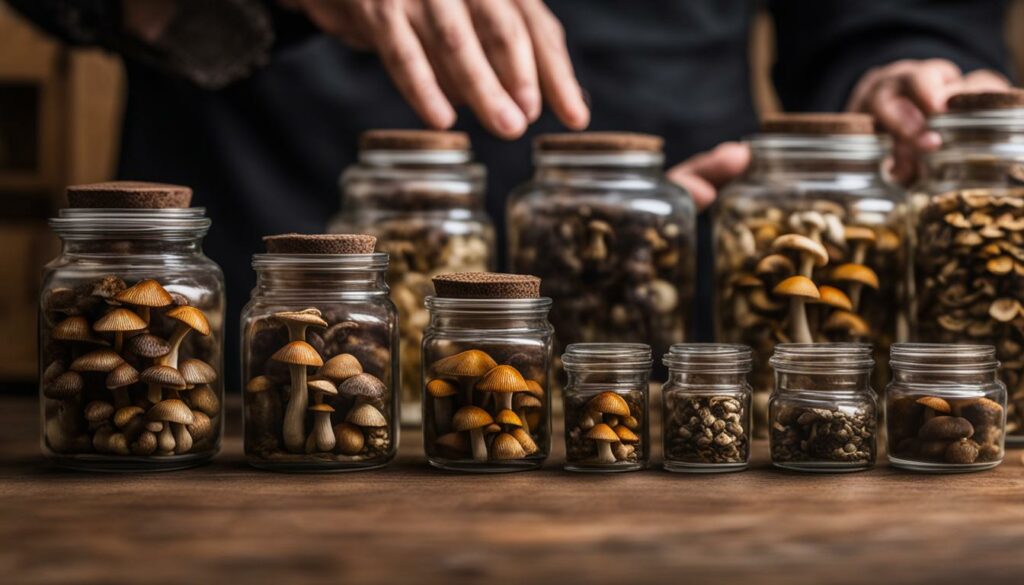
Remember, the potency of magic mushrooms can degrade over time, so it’s always best to consume them as fresh as possible for the most optimal experience.
Conclusion
As we wrap up this guide on shrooms, it’s important to highlight the significance of using them responsibly and being aware of the potential long-term effects. While physical dependence on shrooms is rare, it’s essential to note that psychological dependence and addiction can occur. Therefore, it’s crucial to approach shroom use with caution and respect.
Long-term use of shrooms may impact an individual’s mental health and emotional well-being, especially for those with pre-existing mental health conditions. It’s always advisable to exercise caution and seek professional guidance if needed. Remember, your well-being should always be a top priority.
To ensure a safe and enjoyable experience, it’s essential to follow harm reduction strategies. This includes understanding proper dosage, choosing the right set and setting, and practicing mindfulness during your shroom journey. Taking these precautions can greatly enhance your experience and minimize any potential risks.
So, whether you’re exploring the world of shrooms for therapeutic purposes or simply for personal curiosity, be responsible, know your limits, and prioritize your well-being above all else. Happy shrooming!
FAQ
How much psilocybin is in one gram of magic mushrooms?
One gram of dried Psilocybe cubensis mushrooms contains approximately 10 milligrams of psilocybin.
What is the difference between psilocybin and psilocin?
Psilocybin is the compound found in magic mushrooms, which is converted into psilocin in the body. Psilocin is the active compound responsible for the psychedelic effects.
What are the effects of different psilocybin doses?
A low dose of 1 gram can result in enhanced senses and euphoria, a medium dose of 1.75 grams can produce visuals and heavier euphoria, a high dose of 3.5 grams can lead to full-blown psychedelic experiences, and an ultra-high dose of 5 grams can be overwhelming.
What doses are used in clinical trials?
Clinical trials use doses in the range of 20-30 mg, which can reliably induce mystical-type experiences.
Is there a difference in psilocybin content between mushroom caps and stems?
Studies suggest that mushroom caps of Psilocybe cubensis may have a slightly higher psilocin content on average, but there is significant variability among samples.
How should I store magic mushrooms to preserve potency?
The best way to preserve potency is to store dried mushrooms at room temperature in a dark environment. Psilocybin content can degrade over time, especially when exposed to very cold temperatures. Fresh mushrooms are generally considered to be the most potent.
Are there any long-term effects of using magic mushrooms?
While physical dependence is rare, psychological dependence and addiction can occur. Long-term use may impact mental health and emotional well-being, so it is important to use shrooms responsibly and seek support if necessary.
